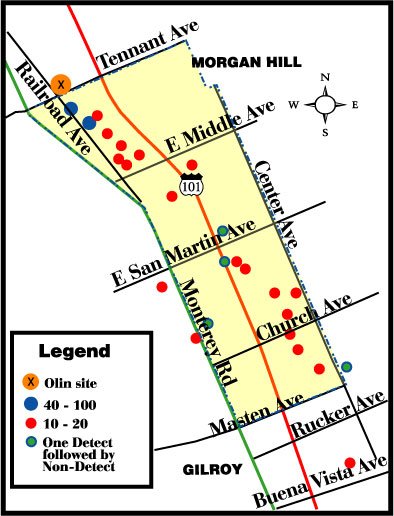SAN MARTIN
– The Santa Clara Valley Water District confirmed Wednesday that
two of the three wells in the West San Martin Water Works system
and one private Gilroy well one mile south of Masten Avenue had
tested positive for the chemical perchlorate.
And, the water district this morning confirmed additional
positive tests for 10 private wells in the southeast quadrant in
the original study area bounded by Tennant, Center and Masten
avenues and Monterey Road, according to Mike DiMarco, a SCVWD
spokesman.
SAN MARTIN – The Santa Clara Valley Water District confirmed Wednesday that two of the three wells in the West San Martin Water Works system and one private Gilroy well one mile south of Masten Avenue had tested positive for the chemical perchlorate.
And, the water district this morning confirmed additional positive tests for 10 private wells in the southeast quadrant in the original study area bounded by Tennant, Center and Masten avenues and Monterey Road, according to Mike DiMarco, a SCVWD spokesman.
“They all tested between four and 10 parts per billion,” he said. All residents with tainted water eventually will be provided with free bottled water, he said.
In the meantime, county health department officials say it is safe to use the water for everything but drinking and cooking.
“Of our three wells, one came in at eight ppb (parts per billion), one at six ppb and one non-detect,” Bob Ukestad, manager of the family-owned WSMWW, said Wednesday night.
The state-mandated “action level” is four ppb. Anything less than that is classified as non-detected. Results from a retest, received Thursday, showed the first well down to 5.4 from eight ppb and the other at five ppb down from six.
The uncontaminated well, Ukestad said, is the largest of the three and, as such, is providing a temporary solution to the problem. Water from the larger well is “blended” with water containing a higher amount, allowing the composite water to be within acceptable levels.
“The water coming out of the system (the blended water) is at non-detect levels,” DiMarco said Thursday.
The West San Martin Water Works serves about 250 homes and businesses in the area west of Monterey Road and south of San Martin Avenue. Included in the service area is the Sig Sanchez County Government Center at Highland Avenue and Monterey Road.
There is one church and no schools in the affected area.
The chemical originated at the now-closed Olin Corp. plant on Tennant and Railroad avenues in Morgan Hill. The company, and Standard Fusee Co., manufactured road safety flares and similar products from 1955-97.
Perchlorate is a by-product of the flare manufacturing process.
The perchlorate leached into the underground water table – the aquifer – and traveled, mostly in a southeasterly direction, according to SCVWD.
Ukestad said they had not yet decided what measures to take.
“This is only one option,” he said.
Other options are under study and discussion, DiMarco said.
Southern California and Nevada, among other states, have been facing far higher levels of perchlorate contamination since it is also a residue of the rocket fuel used by the defense industry.
WSMWW is waiting for the results of further testing, by the SCVWD on Tuesday and Olin Corp. on Wednesday.
“They asked for a quick turn around,” he said, “and we may have the results this week.”
It usually takes three weeks for lab results to be available. Different laboratories are handling the sampling.
“At this time,” Ukestad said, “there is no requirement for bottled water and it is OK to do anything with this water but drink and cook.”
Ukestad also said that if the new tests by Olin and the water district come back positive, Olin will provide free bottled water for all residents on the system.
He said the WSMWW notified its customers by mail on Tuesday.
“We are waiting for more data; at this point there are more questions than answers.”
Ukestad had a good word for the agencies involved with the perchlorate problem.
“I am very appreciative of the support from the agencies: the Department of Health Services, the Santa Clara Valley Water District and the Central Coast Water Quality Control Board.”
This is the first time a well from a public water system has been affected since the Morgan Hill Tennant Avenue well was closed in April 2002.
Gilroy, too
The private well, between Rucker and Buena Vista Avenues, is the first Gilroy well found to be contaminated. It is one mile outside the previously known southernmost boundary of contamination – Masten Avenue – and tested at five ppb at a depth of 100 feet.
The six families getting their water from the well, at the corner of Denio Avenue and Malo Court, have not been contacted for free bottled water, according to the well’s owner who did not want to give her name. She was concerned that the well is located near Llagas Creek and wondered if the creek could be contaminated.
East of Monterey
For the 200 San Martin homeowners on the public water system east of Monterey Road – the news from the San Martin Water District is better.
“Our last test was non-detect,” Peter Forest, the company’s manager, said Wednesday. “They just pulled another sample two weeks ago. In August, though, we showed 5.2 ppb.”
An October re-test showed non-detect. The SMWCD is tested quarterly unless there is reason to test more frequently, as it is now, he said.
San Martin/Gwinn Elementary School gets its water from the SMWCD’s perchlorate-free system.
Forest did offer a bit of hope for residents on contaminated private wells in his area – Monterey Road to New Avenue.
“In the long term, they can hook into our system,” he said, “because our main line runs along San Martin Avenue.”
This would not be inexpensive, he said.
Olin, by California state law, is mandated to pay for the effects and cleanup of the perchlorate contamination.
“Olin became much more cooperative after the (perchlorate) news hit the big time,” Forest said. “After our earlier hits we requested that they test our wells and they refused.”
Forest said that in September his company contacted the CCWQCB to be added to the list of wells tested by Olin, and Olin acquiesced at that time.”
He said that, in his opinion, Olin may not be totally responsible for all the perchlorate contamination farther from the original source.
“It could come from flares along the railroad tracks, from residue from methamphetamine labs and from ammonium nitrate (an agricultural fertilizer) imported from Chile.”
Forest also had a view of how much perchlorate will cause health problems and the how the action levels are developed.
“Four parts per billion (as the action level) is the same as four drops in an Olympic-sized swimming pool,” he said. “And, the maximum contamination level is based on a one-in-a-million rule. If one million people drink this water for 40 years and one person has a problem, you set the levels there.”
Based on this, Forest questions whether there really is a health hazard from the current perchlorate levels in the Morgan Hill-San Martin area.
“We know there is no new pollution going in,” Forest said, “but we must remove the (contaminated) soil and dilute the underground water.”
“Dilution is the solution to pollution,” he joked. “As the rains happen and if there is no new pollution, the levels will go down.”
But whether it takes five or 10 or 40 years, Forest could not say.
All the latest
The SCVWD will host an informational meeting at San Martín/Gwinn Elementary School, 100 North St., from 7 to 9 p.m. on Wednesday to update south Santa Clara County residents about the potential effects of the perchlorate. The meeting will discuss the cause of the contamination, potential health effects, agricultural concerns and future potential cleanup strategies to safeguard residents. The district has invited representatives from the county’s public health office, the county’s agricultural commissioner’s office, the Central Coast Regional Water Quality Control Board, U.S. Environmental Protection Agency, University of California Cooperative Extension Office and other agencies to attend.
More information on the search for the chemical in South County water systems and help for affected residents is available at www.valleywater.org














